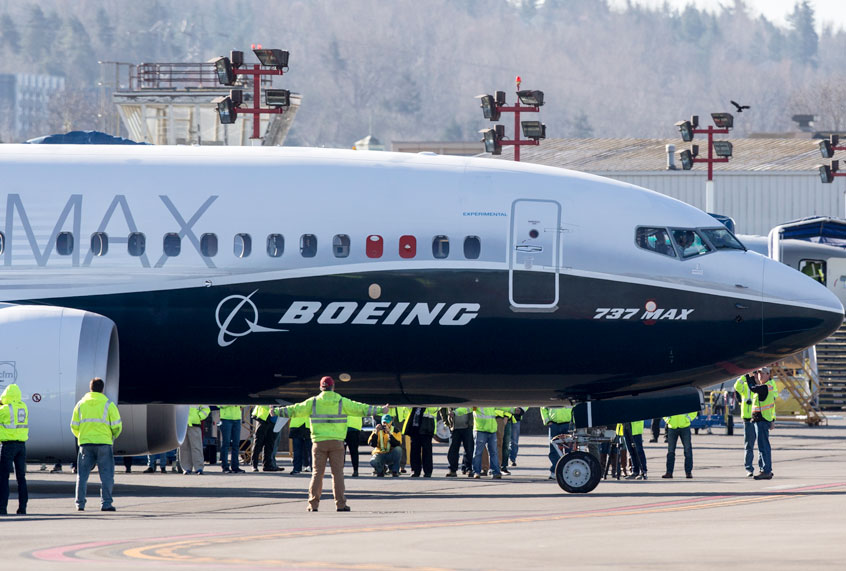Two weeks after Ethiopian Airlines Flight 302 crashed, killing all 157 people on board, details continue to emerge about the cause of the crash — and how it relates to the airline, manufacturer Boeing, and government regulators.
On Sunday March 10, Flight 302 took off from Addis Ababa, Ethiopia’s capital, heading to Nairobi, Kenya. After the crash, many carriers of the aircraft involved, a Boeing 737 Max 8, grounded their fleets. The United States was one of the only countries that did not initially ground its Boeing 737 Max 8s, though after widespread public pressure, President Trump relented.
The Boeing 737 Max 8 was the same plane model that crashed in October in Indonesia, a crash that killed 189 people on board. Officials said then that the aircraft was not airworthy, prompting relatives of Indonesian crash victims to file lawsuits against Boeing. Shortly after that crash, investigators turned their attention to an instrument failure with the Maneuvering Characteristics Augmentation System (MCAS), which could have resulted in the plane crashing.
While the news cycle has subtly moved on to other crises, updates from various outlets who have been following the aftershock closely show that both crashes of the same model may have been more than a coincidence. Here is a timeline of the events post-crash and the state of the Boeing 737 Max 8.
A piecemeal grounding
Even after the rest of the world’s nations grounded the Boeing 737 Max 8, the United States balked; both Southwest Airlines and American Airlines, two of the biggest buyers of the aircraft in the U.S., said they would continue flying it. That caused protest from many American travelers.
Then, last Wednesday, U.S. Federal Aviation Administration (FAA) officials said new evidence from the wreckage of the crash in Ethiopia showed similarities to the crash in Indonesia, which led to groundings of both the Max 8 and Max 9. When the fleets will fly again remains unclear.
Boeing says the 737 Max 8 is “the fastest-selling airplane in Boeing history,” and claims “5,000 orders from more than 100 customers worldwide.” In a recent letter from Boeing’s President and CEO Dennis Muilenburg, Muilenberg the company will release a software update related to pilot training that “will address concerns” prompted after the Indonesia crash. “We’ve been working in full cooperation with the U.S. Federal Aviation Administration, the Department of Transportation and the National Transportation,” he said.
As of March 13, all Boeing 737 Max 8 fleets have remained grounded across the world.
In both crashes, safety features were absent because Boeing charged extra for those
A March 21 report from the New York Times revealed that a key piece of safety hardware was missing on both the Ethiopian aircraft and Indonesian one because Boeing charged extra. According to the report:
Boeing’s optional safety features, in part, could have helped the pilots detect any erroneous readings. One of the optional upgrades, the angle of attack indicator, displays the readings of the two sensors. The other, called a disagree light, is activated if those sensors are at odds with one another.
As the Times reported, add-ons can be very profitable for manufacturers like Boeing, and often, regulators don’t mandate them. By offering the safety feature as an extra, the company can cast blame on the airline for not purchasing it.
Acting Defense Secretary Patrick Shanahan is being investigated for his ties to Boeing
On Wednesday, the Defense Department’s inspector general announced the watchdog was investigating complaints that Acting Defense Secretary Patrick Shanahan had been promoting Boeing, whom he previously worked for, and disparaging its competitors. The investigation was prompted by a watchdog group, Citizens for Responsibility and Ethics. This investigation is not specifically related to the two crashes, but raises questions around the government’s relationship with the company and willingness to protect them.
Department of Transportation’s inspector general to examine approval process
Elaine Chao, the U.S. Secretary of Transportation Secretary, also called for her agency’s internal watchdog to investigate the process through which designs for the 737 Max were approved. In a statement, the Department of Transportation said the audit would be “part of an ongoing review of factors related to aviation certification.” CBC reported on Thursday that sources told the publication that the Department of Justice subpoenaed documents related to the approval process.


